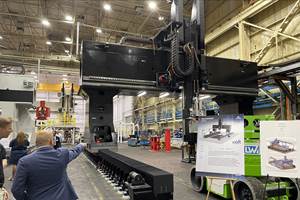Atlas 3D's Sunata AM Software Automates Orientation
The software has also been tested with QuesTek’s Ferrium C64 metal powder.
Share
Read Next
Sunata software from Atlas 3D works with direct metal laser sintering (DMLS) printers, automatically choosing the best orientation for a part, generating support structures and eliminating simulation processes.
Users download designs directly into the cloud-based program and automatically receive the optimal orientation and associated support structures. There are no servers to install and configure and no IT support is needed. Users simply import the STL file, the developer says.
The software’s thermal circuit network (TCN) ensures accuracy and speed by parsing the print design into thermally similar layers, which are then divided into thermally similar segments. It applies a thermal modeling algorithm that runs the design through 100 different orientations to arrive at the optimal orientation and support structure.
The software gives users the ability to scale their requirements from next-to-zero distortion with longer print times, to more tolerable distortion with shorter print times. Because it optimally orients and supports the part, it can give accurate total print time and the amount of sintered material required and provide accurate cost-to-print data. This information, in combination with eliminating waste and rework, enables users to profitably print their designs.
Sunata works with many metal feedstocks and has been tested with QuesTek Innovations’ Ferrium C64 (AMS 6509) metal powder. Ferrium C64 is a high-strength, high-surface hardness and highly fracture-resistant carburizable steel that also has high-temperature resistance and hardenability. It is said to achieve a surface hardness of 62-64 HRC via vacuum carburization. Leading applications for the metal powder include Bell Helicopter and Sikorsky transmission gearboxes.
Under an Army-funded Future Advanced Rotorcraft Drive System (FARDS) program, Bell and Sikorsky are evaluating and qualifying it to displace Alloy X53 (AMS 6308). Benefits would include lighter-weight gear components, increased power density of the helicopter transmission, greater temperature resistance and better pitting and corrosion resistance. In addition, QuesTek is evaluating and demonstrating Ferrium C64 for additively manufactured aerospace gears and fatigue-driven applications under an Army-funded SBIR Phase I program. Other possible applications include racing transmission gears, gears with integral bearing races, and integrally geared drive shafts that require durability, compactness, weight savings, high-temperature resistance, and high-surface fatigue resistance. It can also offer increased performance and reliability of wind turbine transmission gearboxes, reducing maintenance costs and downtime and increasing reliability.
The technology group at Indiana Technology and Manufacturing Company (ITAMCO) worked with the developers at Atlas 3D to create Sunata. It is already manufacturing components with an EOS M 290 3D printer and Sunata, and is interested in Ferrium C64. Given that the company provides open gearing and precision machining services to heavy-duty industries including aviation, energy, mining, off-highway vehicles and marine, the software and metal powder could lead to continued advancement in its AM program.
“As metal additive printing continues to grow, so too does the need to add new printable powders,” says Atlas 3D CEO Chad Barden. “The thermal characteristics of these new powders, however, present their own unique set of challenges. ITAMCO is one of many Atlas 3D customers to benefit from our forward-looking move to add this exciting new material to the list of available metals in Sunata.”
“Atlas 3D’s incorporation of Ferrium C64 steel into the Sunata system will enable others interested in C64 to more efficiently begin building components with this high-performance steel,” adds Jeff Grabowski, QuesTek’s manager of business development.
Related Content
10 Important Developments in Additive Manufacturing Seen at Formnext 2022 (Includes Video)
The leading trade show dedicated to the advance of industrial 3D printing returned to the scale and energy not seen since before the pandemic. More ceramics, fewer supports structures and finding opportunities in wavelengths — these are just some of the AM advances notable at the show this year.
Read MoreWorld’s Largest Metal 3D Printer Seen at Ingersoll Grand Opening Event
Maker of large additive and subtractive machines adds capacity in Rockford, Illinois.
Read MoreAM 101: What Is Binder Jetting? (Includes Video)
Binder jetting requires no support structures, is accurate and repeatable, and is said to eliminate dimensional distortion problems common in some high-heat 3D technologies. Here is a look at how binder jetting works and its benefits for additive manufacturing.
Read MoreHow to Build 10,000+ Shot Molds in Hours
Rapid tooling isn’t so rapid when it takes days to 3D print a metal mold, and then you still must machine it to reach the necessary tolerances. With Nexa3D’s polymer process you can print a mold in hours that is prototype or production ready and can last for more than 10,000 shots.
Read MoreRead Next
4 Ways the Education and Training Challenge Is Different for Additive Manufacturing
The advance of additive manufacturing means we need more professionals educated in AM technology.
Read MoreHybrid Additive Manufacturing Machine Tools Continue to Make Gains (Includes Video)
The hybrid machine tool is an idea that continues to advance. Two important developments of recent years expand the possibilities for this platform.
Read MoreAt General Atomics, Do Unmanned Aerial Systems Reveal the Future of Aircraft Manufacturing?
The maker of the Predator and SkyGuardian remote aircraft can implement additive manufacturing more rapidly and widely than the makers of other types of planes. The role of 3D printing in current and future UAS components hints at how far AM can go to save cost and time in aircraft production and design.
Read More




















